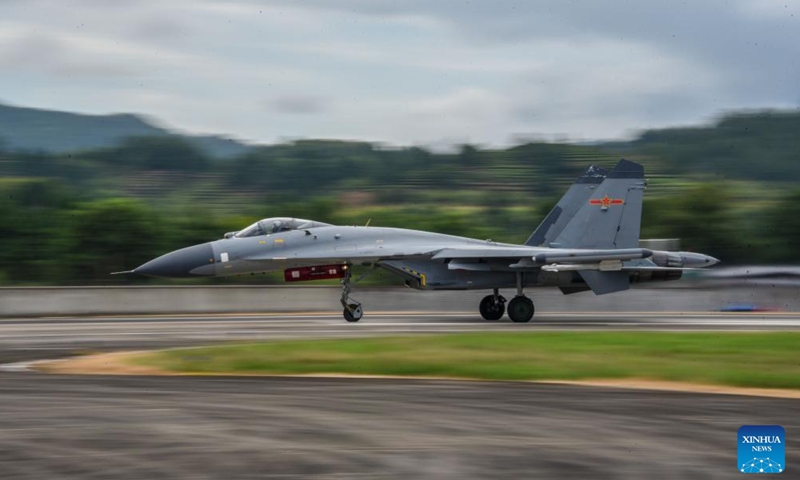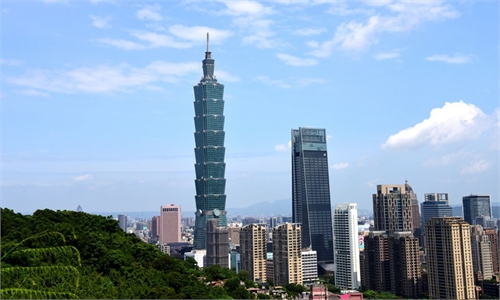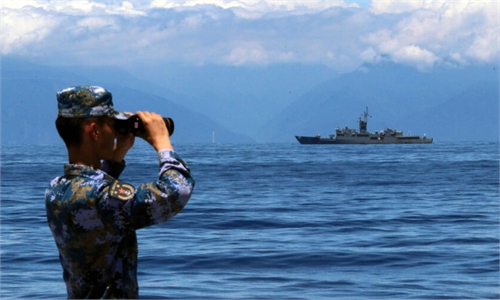Mainland holds initiative in the Taiwan Straits, regardless of the US strategic ambiguity or clarity

A warplane of the Eastern Theater Command of the Chinese People's Liberation Army (PLA) takes off during joint combat training exercises around the Taiwan Island, Aug. 7, 2022.Photo:Xinhua
The debate of whether the US should shift its Taiwan policy of "strategic ambiguity" to "strategic clarity" is never ceasing. The heat has recently gone even higher with new US provocative moves in the Taiwan Straits.
On the one hand, the US adopts "porcupine strategy" to help Taiwan island build defenses. On the other, US politicians like House Speaker Nancy Pelosi keep making provocative visit to Taiwan, creating domestic conditions for some forces within the US to advocate for changing the US' Taiwan policy from "strategic ambiguity" to "strategic clarity."
The policy of strategic ambiguity in the Taiwan Straits allows the US to remain deliberately ambiguous on the question of whether to defend Taiwan once a conflict occurs. For the US, it means it could sustain a peaceful status quo in the Straits and maintain working relationships with both the Chinese mainland and Taiwan island.
Xin Qiang, deputy director of the Center for American Studies at Fudan University, told the Global Times that although there have been constant voices within the US calling for the abandonment of "strategic ambiguity," the US will not easily change this strategic posture as long as the US remains basic policymaking rationality. But he warned that in practice, the US will adopt salami-slicing tactics such as increasing political exchanges and enhancing economic activities with Taiwan.
Lü Xiang, a research fellow at the Chinese Academy of Social Sciences, believed that this is actually the way the US is gradually moving toward "strategic clarity," which will not be expressed publicly, but will be accompanied by blackmail-type statements. Strategic ambiguity is becoming less and less meaningful to Washington.
The direction of the US' Taiwan strategy, and the degree of strategic ambiguity or clarity toward Taiwan, depends on the development of international situation and circumstances in the Taiwan Straits, and more importantly, on the balance between the strength of China and the US. The stronger the Chinese mainland is, the less likely the US will move toward strategic clarity because of the higher risk.
Pro-Taiwan hawks in the US think that a clear and explicit US attitude of a military involvement in the Taiwan Straits would prevent the Chinese mainland from reunifying the island of Taiwan by force. However, such thinking overemphasizes US dominance over the situation in the Taiwan Straits. The situation in the Straits and the direction of cross-Strait relations are ultimately in the hands of the Chinese mainland. The US "strategic clarity" will only prompt Beijing to make a decisive decision to completely resolve the problem of "Taiwan independence."
The US is well aware that if it continues its strategic ambiguity over the Taiwan question and doesn't make it clear to "defend Taiwan," it will be able to use the island as a leverage in its relations with China. However, with a promise to "defend Taiwan," Washington will in turn become a pawn used by the Democratic Progressive Party authorities, which will leave the US more embarrassed.
The Chinese mainland is indeed stepping up preparations for military struggle in the Taiwan Straits. But what it confirms is not its belligerence, but a determination of never allowing anyone to split Taiwan from China. The preparations for military struggle are not the source of tension in the Taiwan Straits. On the contrary, it is the Taiwan authorities' plot for independence and the collusion between Taiwan and the US to undermine the one-China principle that is the source of tension.
The possibility that the US military has the strength to defeat the PLA in the Taiwan Straits is getting smaller and smaller. The US has also gradually lost the confidence to invest in a large number of servicemen and national resources in a desperate fight in the Taiwan Straits. The discussion of "strategic clarity" can only be bluffs, and the kinds of resources that can support the determination of the US are dwindling.
After Pelosi's visit to Taiwan, China has taken a series of countermeasures, which have formed a deterrent effect on the US executive branch, Congress and anti-China forces. There was no drastic response or retaliation by the US military or executive branch. This shows that the US knows that its challenge of China's red line on the Taiwan question is unjustified, said Xin Qiang from Fudan University. The military drills are China's correction of the imbalance in the Taiwan Straits, which is a strategic rebalancing.
Xin said that through the military drills, the Chinese mainland has established a new normal in the Taiwan Straits, which is favorable for the mainland and certainly not good for "Taiwan independence" forces. For the US, since the space for "Taiwan independence" forces has been compressed, the US' control over the situation in the Taiwan Straits has been weakened. The US has also seen the determination, will and ability of the Chinese mainland to resolutely resist the US using Taiwan as a pawn. What ultimately determines the direction of the Taiwan Straits is not "strategic ambiguity" or "strategic clarity" of the US, but the will and strength. The initiative is firmly on China's side.
The author is a reporter with Global Times. opinion@globaltimes.com.cn



